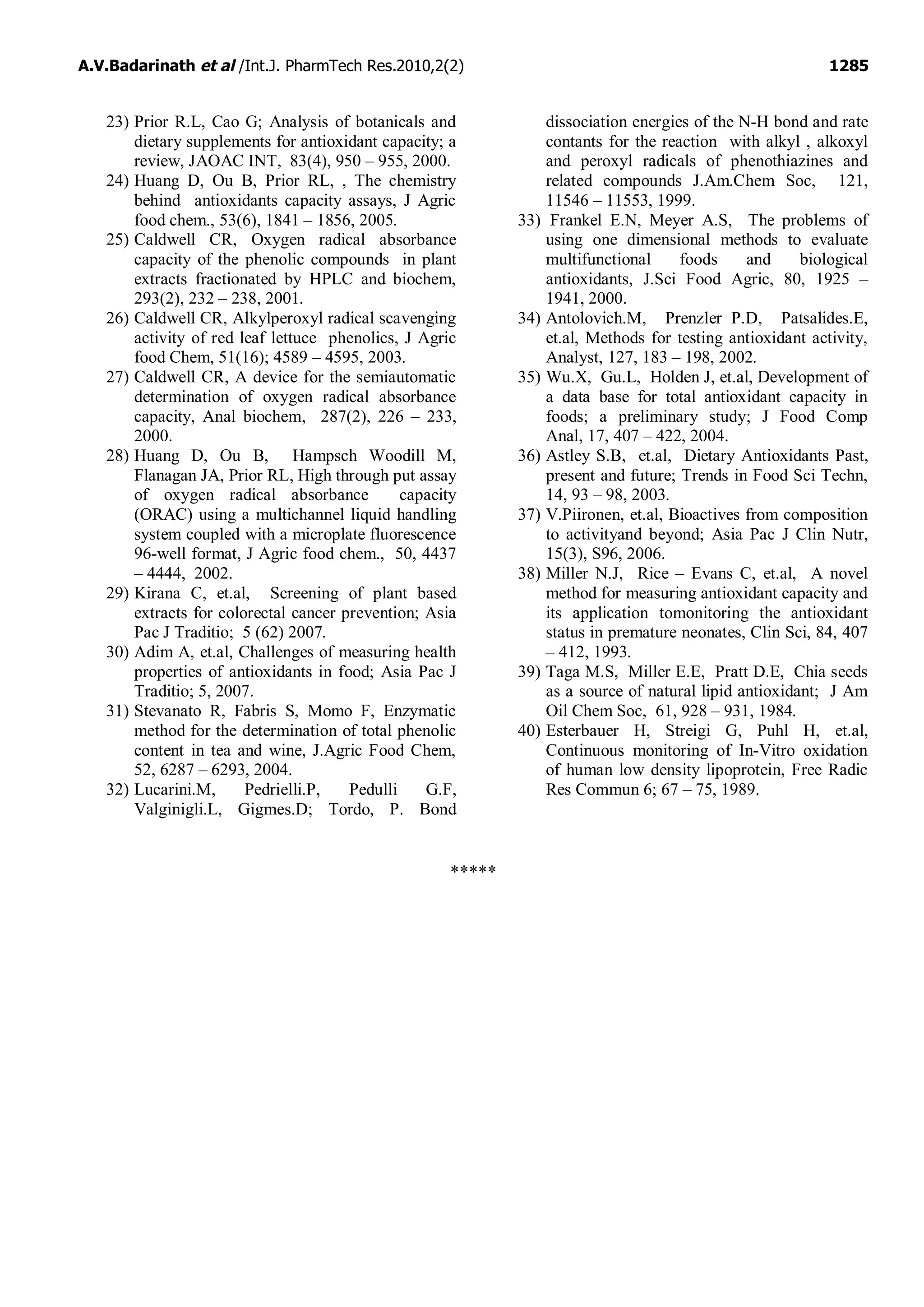This document provides an overview and comparison of various in-vitro methods used to measure antioxidant activity, including their advantages and disadvantages. It summarizes several common methods such as the Thin Layer Chromatography autography technique, Cellular Antioxidant Activity assay, Dye-Substrate oxidation method, and Cupric Ion Reducing Antioxidant Capacity method. The document emphasizes selecting methods based on feasibility, simplicity, required instrumentation and ability to effectively analyze antioxidant properties.
![International Journal of PharmTech Research
CODEN (USA): IJPRIF ISSN : 0974-4304
Vol.2, No.2, pp 1276-1285, April-June 2010
A Review on In-vitro Antioxidant Methods:
Comparisions, Correlations and Considerations
A.V.Badarinath*
, K. Mallikarjuna RAo, C.Madhu Sudhana Chetty, S. Ramkanth,
T.V.S Rajan, K.Gnanaprakash
Department of Pharmaceutics, Annamacharya College of Pharmacy,
New boyanapalli, Rajampeta – 516126, Kadapa, Andhra Pradesh, India
*Corres.author: avbadrinatha@rediffmail.com
Phone No: 09440916296
Abstract: This stimuli article provides an overview general aspect, their comparisons, correlations and considerations
of various In-Vitro methods to measure the antioxidant defense system and to discuss a number of updated In-Vitro
methods used for detection of antioxidant properties. This review article gives the information regarding the different
methods that are used to perform the In-Vitro antioxidant activity. It emphasizes the method simplicity, time required,
instrumentation which makes us to decide which method to be fallowed to perform antioxidant property based on the
feasibilities afforded to determine it. It makes a glance regarding the advantage of different methods and which is most
common method used in present days for effective analysis. On the other hand as there are advantage there may be some
disadvantages which are also mentioned in this article. The research studies should also be carried mostly on the
accurate methods for exact results which also act as a good reference for the further researches.
Key words: In-Vitro antioxidant methods, Cellular antioxidant activity, Cellular antioxidant activity, Semi quantitative
analysis, Folin-Ciocalteu method.
Introduction
A antioxidant is a chemical that prevents the oxidation
of other chemicals. They protect the key cell
components by neutralizing the damaging effects of
free radicals, which are natural by- products of cell
metabolism.1,2
Free radicals form when oxygen is
metabolized or formed in the body and are chemical
species that posses an unpaired electron in the outer
(valance) shell of the molecule. This is the reason, why
the free radicals are highly reactive and can react with
proteins, lipids, carbohydrates and DNA. These free
radicals attack the nearest stable molecules, stealing its
electron. When the attacked molecule loses its
electron, it becomes a free radical itself, beginning a
chain reaction, finally resulting in the description of a
living cell3
. Free radicals may be either oxygen derived
(ROS, reactive oxygen species) or nitrogen derived
(RNS, reactive nitrogen species). The oxygen derived
molecules are O-
2 [superoxide], HO[hydroxyl] ,HO2
[hydroperoxyl], ROO[peroxyl], RO[alkoxyl] as free
radical and H2O2 oxygen as non-radical. Nitrogen
derived oxidant species are mainly NO [nitric oxide],
ONOO [peroxy nitrate], NO2 [nitrogen dioxide] and
N2O3[dinitrogen trioxide].4,5
In a normal cell, there are
appropriate oxidant: antioxidant balance. However,
this balance can be shifted, when production species is
increased or when levels of antioxidants are
diminished. This stage is called oxidative stress.
Oxidative stress results in the damage of biopolymers
including nucleic acids, proteins, polyunsaturated fatty
acids and carbohydrates. Lipid peroxidation is
oxidative deterioration of polyunsaturated lipids and it
involves ROS and transition metal ions. It is a
molecular mechanism of cell injury leading yield a
wide range of cytotoxic products, most of which are
aldehydes, like malondialdehyde (MDA), 4-
hydroxynonrnal(HNE), Oxidative stress causes serious
cell damage leading to a variety of human diseases6
like Alzheimer’
s disease, Parkinson’s disease,
atheroscleorosis, cancer, arthritis, immunological
incompetence and neurodegenerative disorders, etc.
Nutritional antioxidant deficiency also leads to
oxidative stress, which signifies the identification of](https://image.slidesharecdn.com/areviewonantioxidantmethods-141009224254-conversion-gate02/75/A-review-on-antioxidant-methods-1-2048.jpg)
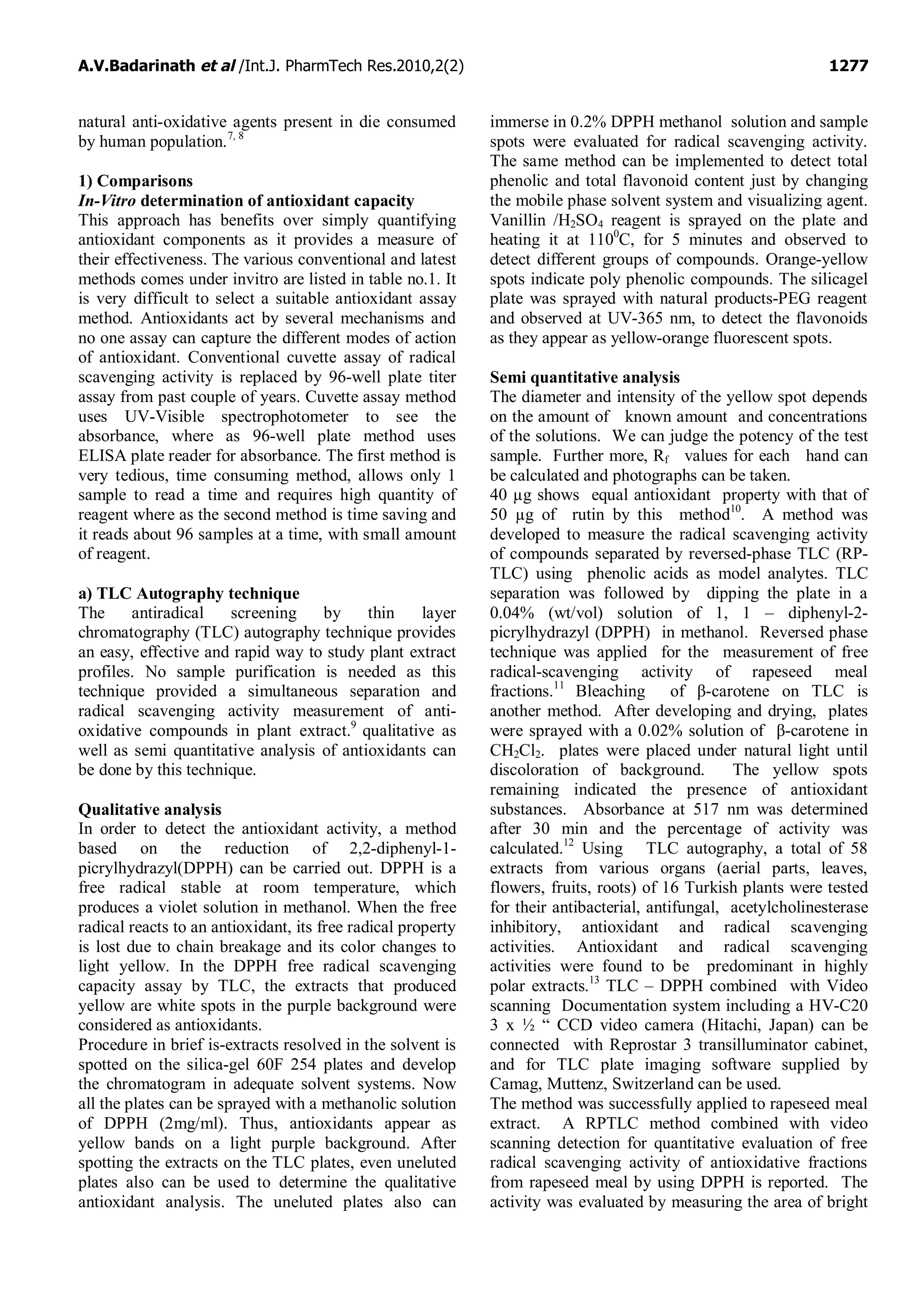
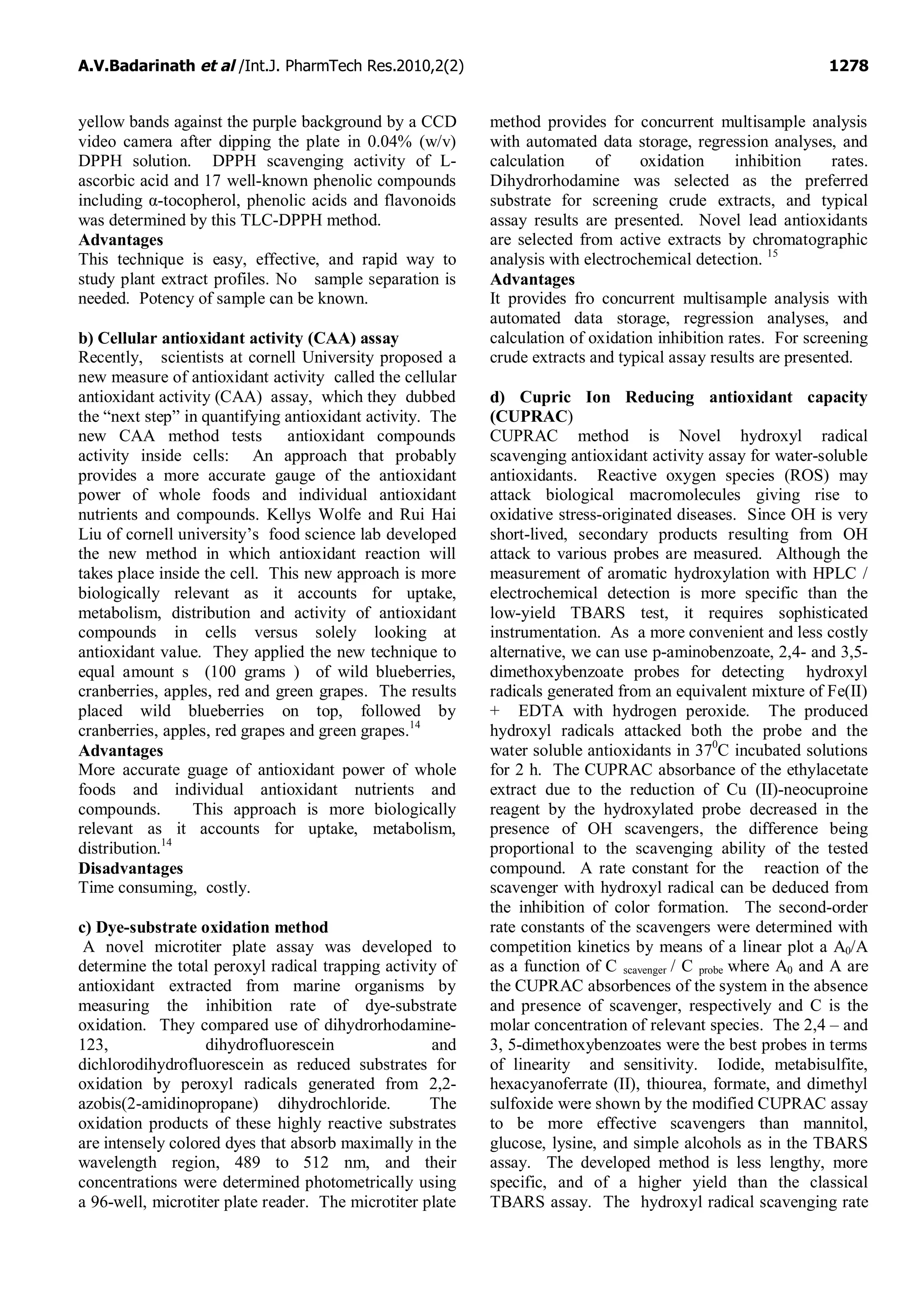
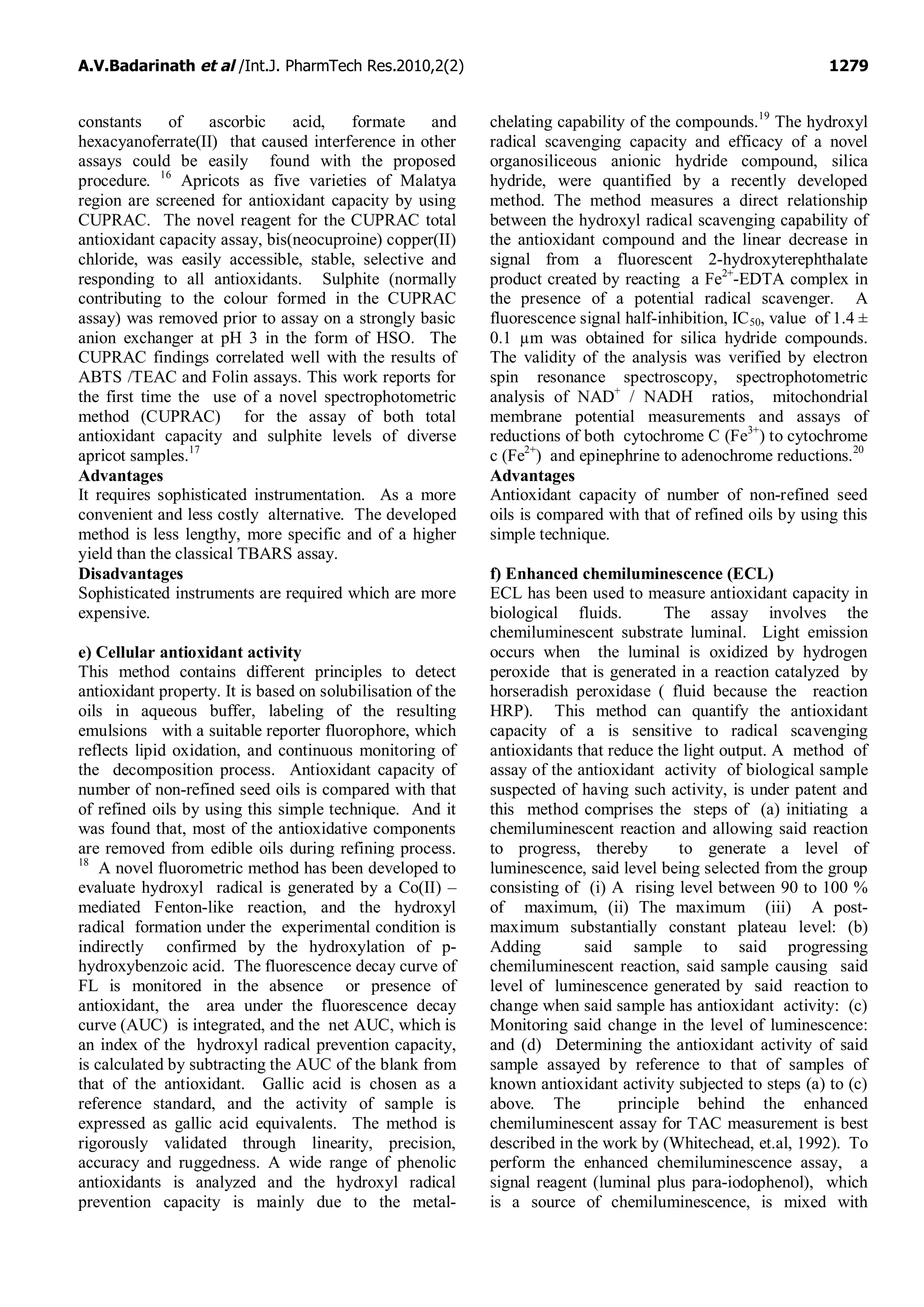
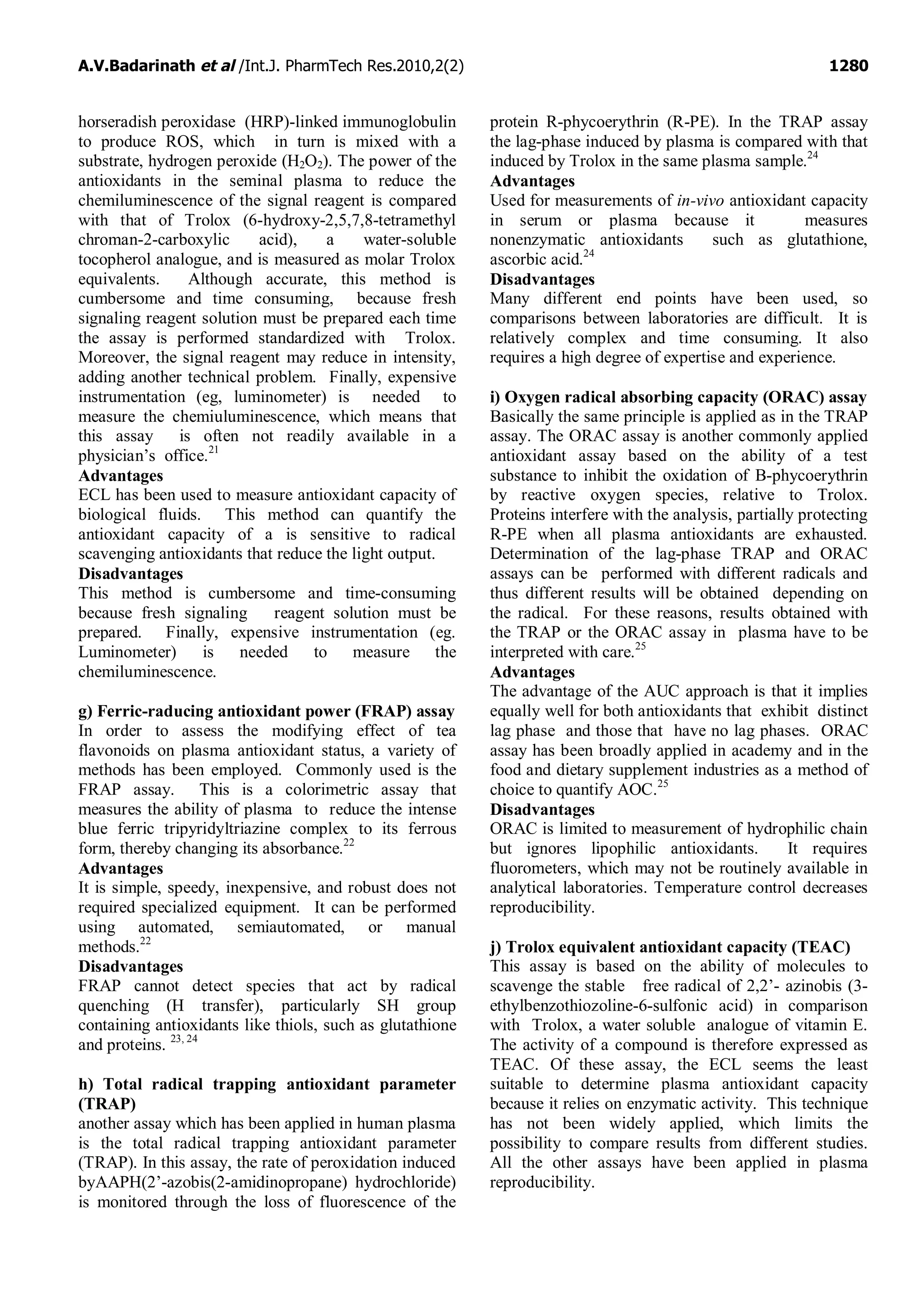
![A.V.Badarinath et al /Int.J. PharmTech Res.2010,2(2) 1281
k) ABTS {2,2’ – azinobis-(3-ethyl-benzothiazoline-
6-sulphonic acid)}
Miller et al (1993) described another technique for
TAC measurement based on colorimetry. This assay is
based on the principle that when 2,2’-azinobis-(3-
ethyl-benzothiazoline-6-sulphonic acid) {ABTS} is
incubated with a peroxidase (such as metmyoglobin
and H2O2, a relatively stable radical cation, ABTS+
, is
formed (see equation below). The formation of
ABTS+
on Interaction With Ferryl Myoglobin
produces a relatively stable blue-green color,
Measured at 600nm. Antioxidants in the fluid sample
suppress this color production to a degree that is
proportional to their concentrations. In this equation,
HX-FeIII
= metmyoglobin, X – [FeIV
= 0] =
ferrylmyoglobin, ABTS = 2,2’
– azino-di-[3-ethyl-
bensthiazoline sulphonate].38
l) Folin-Ciocalteu method
The total flavonol content was expressed as rutin
equivalent in mg/g or %W/W of the extracts. The
AICl3 method (Lamaison and Carnet, 1990) was
used for determination of the total flavonoid content of
the sample extracts. Aliquots of 1.5 ml of extracts
were added to equal volumes of a solution of 2% AlCl3
Y 6H2O (2 g in 100 ml methanol). The mixture was
vigorously shaken, and absorbance at 367 nm was read
after 10 min of incubation. Flavonoid contents were
expressed as mg catechin equivalent /g dry weight.39
The Conjugated Dienes (CD) were quantified by
measuring the absorbance at 234 nm, according to
Esterbauer by as follows. A mixture of linoleic acid
is emulsified with Tween 20 in phosphate buffer (pH
7), at a final concentration of 10mm was incubated
alone (control) or with the plant extract (sample). The
oxidation was initiated by the addition of freshly
prepared copper sulphate. The oxidation can be
stopped by cooling in an ice bath, in the presence of
EDTA and BHT, Oxidation kinetics were determined
at 370
C , by measuring the absorbance at above
mentioned nm for every 15 minutes over 270
minutes.40
The qualification of TBARS was
monitored, according to the ohkawa method. Briefly,
the plant extract was added to linolenic acid emulsion
in phosphate Buffer solution (PBS), and Tween20.
The oxidation can be initiated by freshly prepared
copper sulphate solution. After incubation at 370
C for
3 hours, in obscurity, the reaction was stopped by
cooling and adding EDTA. The BHT was used as a
standard antioxidant. This preparation is combined
with trichloroacetic acid thiobarbuturic acid, was
heated in boiling water for 45 minutes and then cooled
at room temperature. TBARS were extracted with n-
butanol and the absorbance of the n-butanol layer was
measured at 532 nm.40
2. Correlations
The developed method CUPRAC is less lengthy, more
specific, and of a higher yield than the classical
TBARS assay. Thus we can say that there is a
correlation in between these two methods.16
The
CUPRAC finding correlated well with the results of
ABTS/TEAC and Folic assays. This work reports for
the first time the use of a novel spectrophotometric
method (CUPRAC) for the assay of both total
antioxidant capacity and sulphite levels of diverse
apricor samples.17
The hydroxyl radical scavenging
capacity and efficacy of a novel organosiliceous
anionic hydride compound, silica hydride, were
quantified by a recently developed method. The
method measures a direct relationship between the
hydroxyl radical scavenging capability of the
antioxidant compound and the linear decrease in
signal from a fluorescent 3-hydroxyterephthalate
product created by reacting an Fe2+
-EDTA complex in
the presence of a potential radical scavenger. Hence
we can say that there is a correlation.20
Determination
of the lag-phase TRAP and ORAC assays can be
performed with different radicals and thus different
results will be obtained depending on the radical.
Hence we can say that there is no correlation. A
comparison of the result of the assays showed that the
ability to inhibit peroxidation of lipids in a liposomal
system (LPIC) correlated well with the cytoprotective
activities. If a single plant is assayed for its
antioxidant activity by different technique, each
technique gives the different results. Significant
correlations were found between TPC, SASA and
DPPH for the commercial coffee drubjs ub cguba.29
A
comparison of the antioxidant results of the three
flavonoids (quercetin, rutin and catechin), shows a
well correlation between LPO and ORAC methods. 30
Three assays were compared for the determination of
total antioxidant capacity in human serum: the
(ORAC) assay, the Randox Trolox-equivalent
antioxidant capacity (Randox-TEAC) assay, and the
ferric reducing ability (FRAP) assay. There was a
weak but significant linear correlation between serum
ORAC and serum FRAP. There was no correlation
either between serum ORAC and serum TEAC or
between serum FRAP and serum TEAC. Numerous
publications applied the total phenols assay by FCR
and an ET based antioxidant capacity assay and often
found excellent lineal correlations between them.31
The TEAC values for pure antioxidant compounds do
not show clear correlation between TEAC values and
the number of electrons an antioxidant can give away.
The TEAC values of ascorbic acid (1.05), alfa –
tocopherol (0.97), glutathione (1.28), and uric acid
(1.01) are almost the same, although glutathione can
normally donate one electron whereas the others are
two electron reductants.25
Radical trapping capacity](https://image.slidesharecdn.com/areviewonantioxidantmethods-141009224254-conversion-gate02/75/A-review-on-antioxidant-methods-6-2048.jpg)
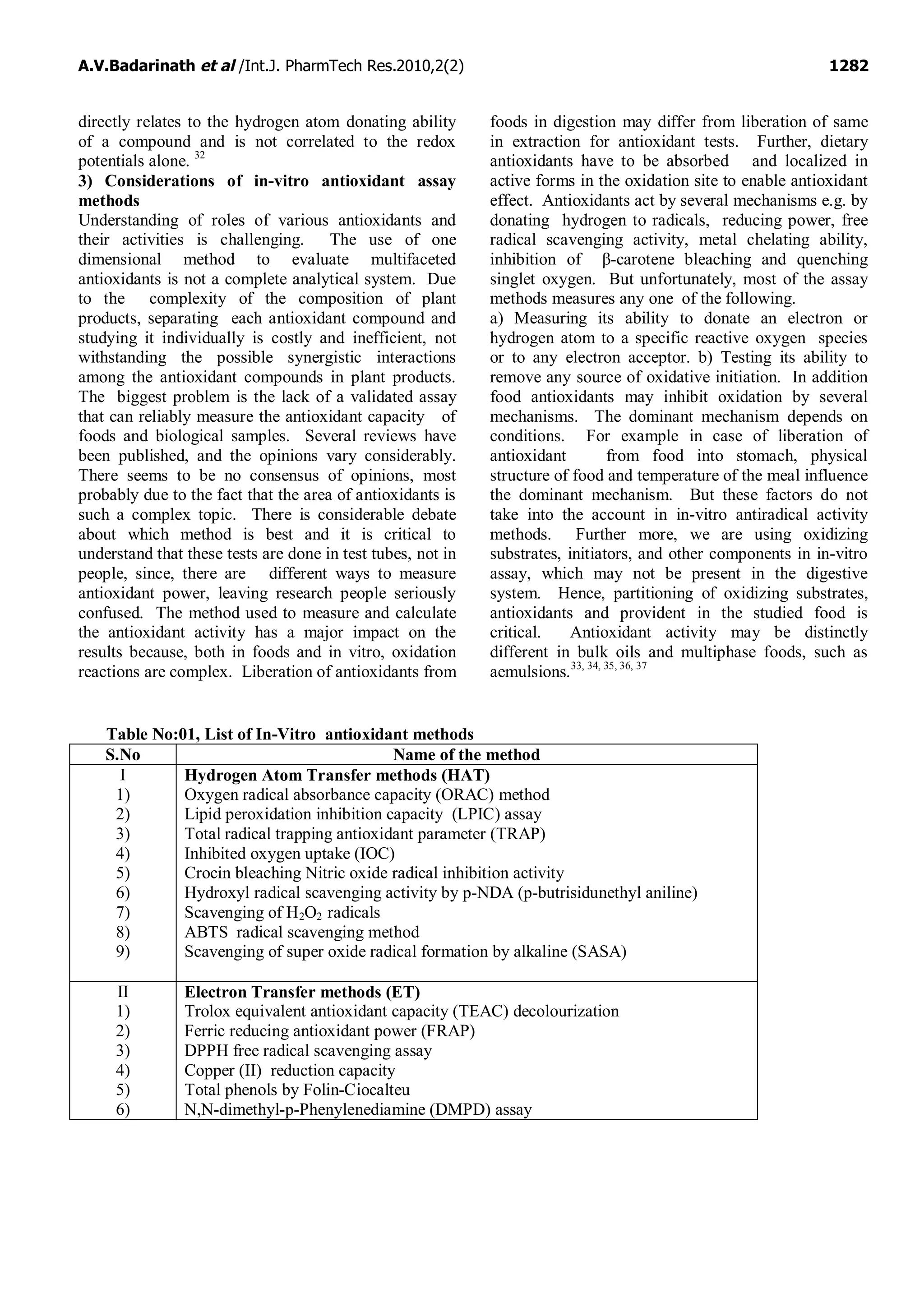
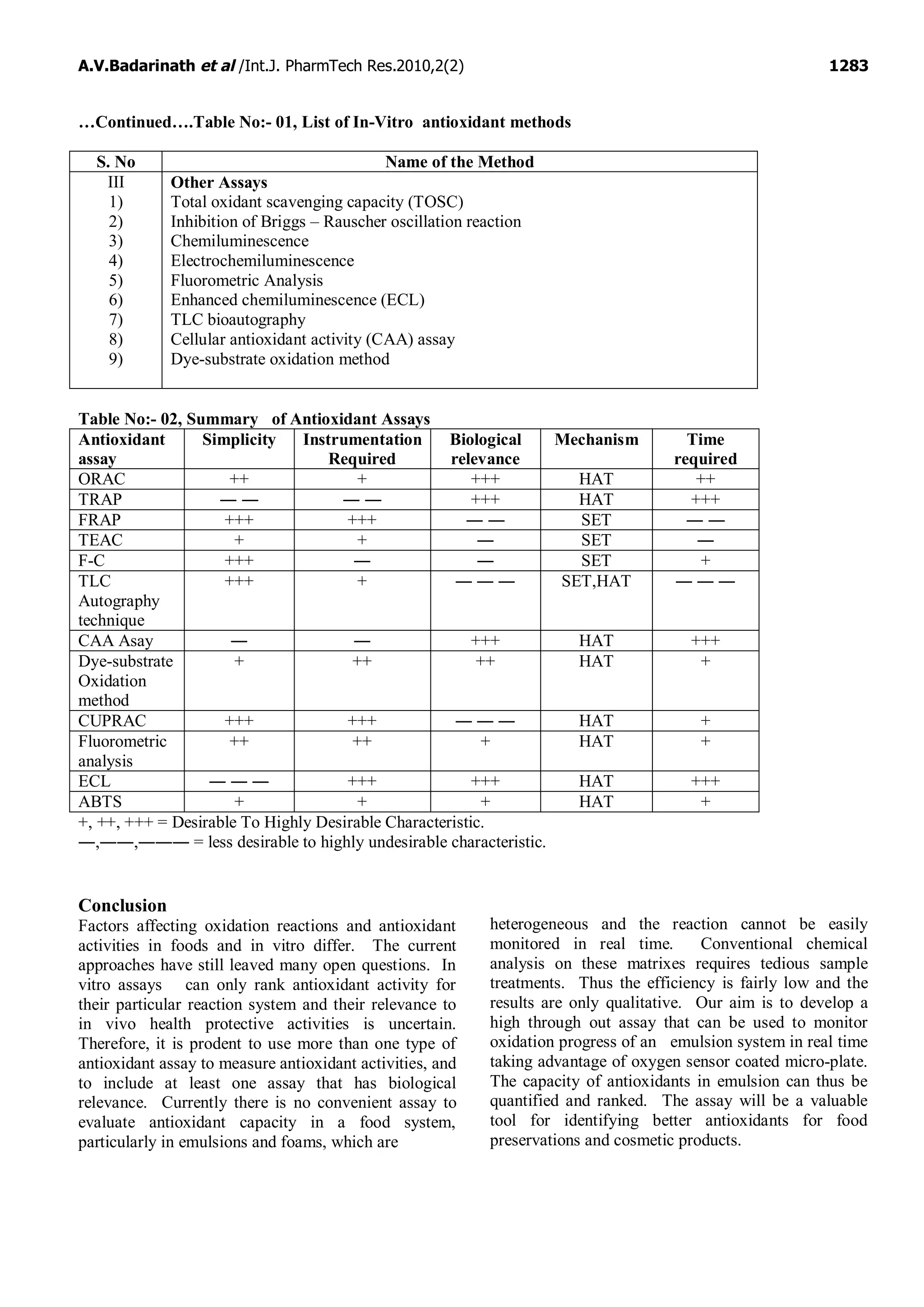
![A.V.Badarinath et al /Int.J. PharmTech Res.2010,2(2) 1284
References
1) Ames B.N, Shigenega M.K, Hagen T.M,
“Oxidants and the degenerative diseases of
ageing” Proc Nati Acad Sci , 90: 7915 – 22,
1993.
2) Shenoy R, Shirwaikar A, “Anti-inflammatory
and free radical scavenging studies of Hyptis
suaveolens (labiatae)” Indian drugs: 39, 574 –
577, 2002.
3) Patil S Jolly CI, Narayanan S, free radical
scavenging activity of acacia catechu and
Rotula aquatica: implications in cancer
therapy, Indian drugs: 40, 328 – 332, 2003.
4) Evans P, Halliwall B, “Free radicals and
hearing” Ann N Y Acad Sci, 884: 19, 1999.
5) Devasagayam T.P.A, Kesavan P.C, “radio
protective and antioxidant action of caffeine :
mechanistic considerations, Indj exp boil; 41,
267 – 269, 2003.
6) Peterhans E, “Oxidants and antioxidants in
viral diseases; disease mechanisms and
metabolic regulation, J.Nutr; 127, 962, 1997.
7) Sies H, Stahl W, “Withania somnifera, vitamin
E and C, [beta]-carotene and other carotenoids
as antioxidants. Am J Clin nutr; 62, 1315S –
1321S, 1995.
8) Parker R.S, “Dietary and biochemical aspects
of Vitamin E” Adv food nutr res, 33: 157 –
232, 1980.
9) Li Peiwu, Anu Hopia, Jari S., Teijo
Yrjonenand Heikki Vuorela; “TLC method
for evaluation of free radical scavenging
activity of rapeseed meal by video scanning
technology; 10th
international rapseed
congress; Canberra; Australia; 1999.
10) Patricia de Almeida Telles Macari; Cintia
Nicacio Portela; Adrian Martin Pohlit;
Atividade antioxidante, citotoxica e absorcao
no UVB de extratos da casca de Maytenus
guyanensis Klotzch (Celastraceae); Acta
Amaz. Vol: 36, 4, 2006.
11) Teijo Yrojonen, Li Peiwu, Jari Summanen,
Anu Hopia and Heikki vuorela: Free radical
scavenging activity of phenolics by reversed
phase TLC; Journal of the American Oil
Chemists’ Society : 80(1), 9 – 14, 2003.
12) Alan Bezerra Ribeiro; Dulce Helena Siqueira
Silva; Vanderlan da Silva Bolzani;
Antioxidant flavonol glycosides from
Nectandra grandiflora (Lauraceae); Eclet,
Quim, 27, 2002.
13) Deniz Tasdemir A, Ali Domez B, Ihsan
Calinodots C; petr Riiedi; “ Evaluation of
Biological activity of Turkish Plants, Rapid
Screening for the Antimicrobial, Antioxidant
and Acetylcholinesterase Inhibitory Potential
by TLC Bioautographic Methods” Journal of
Pharmaceutical Biology, 42 (4), 374 – 383,
2004.
14) Craig Weatherby, “Wild Blueberies Reclaim
Antioxidant Crown” vital choices, 4 , 187,
2007.
15) Walter Dunlap, Lyndon Liewellyn, Jasnon
Doyle and Yorihiro Yamamoto; A Microtiter
Plate Assay for Screening Antioxidant
Activity in Extracts of Marine; Jor of Marine
Biotechnology, 5(3), 294 – 301, 2003.
16) Burcu Bektasoglu, Saliha Esin Celik, Mustafa
Ozyurek, Kubilay Guclu and Resat Apak;
Novel hydroxyl radical scavenging antioxidant
activity assay for water soluble antioxidants
using a modified CUPRAC method; Jor of
Marine Biotechnology; 5(3), 2003.
17) Guclu, Kubilay , Altun, Mehmet, Ozyurek,
Mustafa, Karademir, Saliha E, Apak, Resat;
Antioxidant capacity of fresh, sun and
sulphited dried Malatya apricot (Prunus
armeniaca) assayed by CUPRAC,
ABTS/TEAC and folin methods; International
journal of Food Science & Technology, 41(1),
76 – 85, 2006.
18) Gilbert Otto Fruhwirth, Thomas Wenzl,
Rosemarie El-Toukhy, Franz Siegfried
Wagner, Albin Hermetter; Fluorescence
screening of antioxidant capacity in pumpkin
seed oils and other natural oils; European
Journal of Lipid Science and Technology;
105(6).
19) Ou, B.N., Hampsch Woodill, M. Flanagam.J,
Deemer.E.K, Prior, R.L, Huang D.J; Novel
fluorometric assay for hydroxyl radical
prevention capacity using fluorescein as the
probe; Journal of Agricultural and Food
Chemistry, 50, 2772 – 2777, 2002.
20) Cory J, Stephanson, Anne M.Stephanson,
G.Patrik Flanagan; Evaluation of Hydroxyl
Radical Scavenging Abilities of Silica
Hydride, an antioxidant compound, by a Fe2+
-EDTA Induced 2-Hydroxyterephtalate
Fluorometric Analysis, Journal of Medicinal
Food, 6(3), 249 – 253, 2003.
21) Whitehead TP, Thorpe GHG, Maxwell SRJ;
Enhanced Chemiluminescent assay for
antioxidant capacity in biological fluids, Anal
Chim Acta, 266, 265 – 277, 1992.
22) Benzie IF, Strain JJ, Ferric reducing
antioxidant power assay; direct measure of
total antioxidant activity of biological fluids
and modified version for simultaneous
measurement of total antioxidant power and
ascorbic acid concentration methods enzymol,
299, 15 – 27, 1999.](https://image.slidesharecdn.com/areviewonantioxidantmethods-141009224254-conversion-gate02/75/A-review-on-antioxidant-methods-9-2048.jpg)
